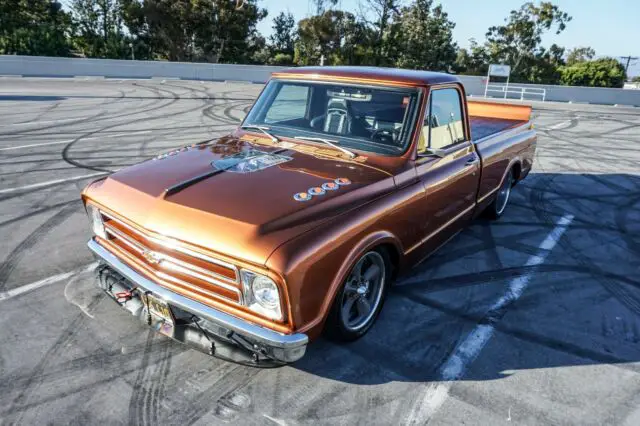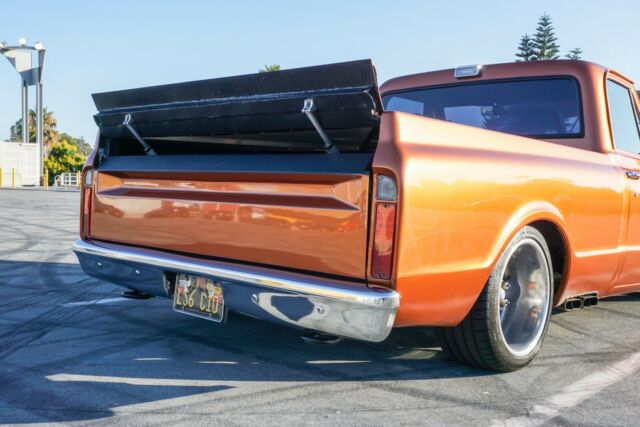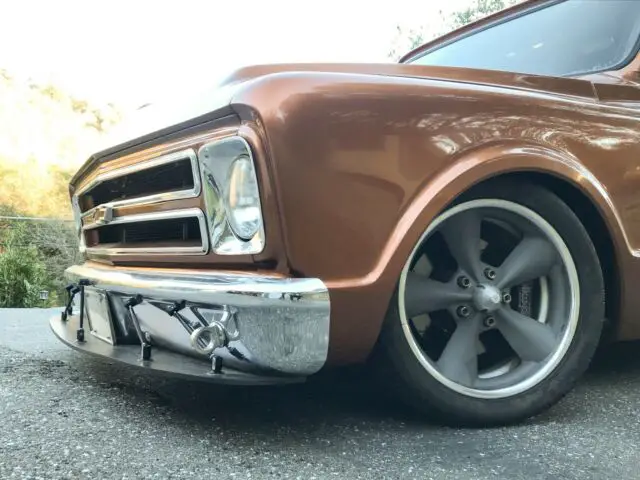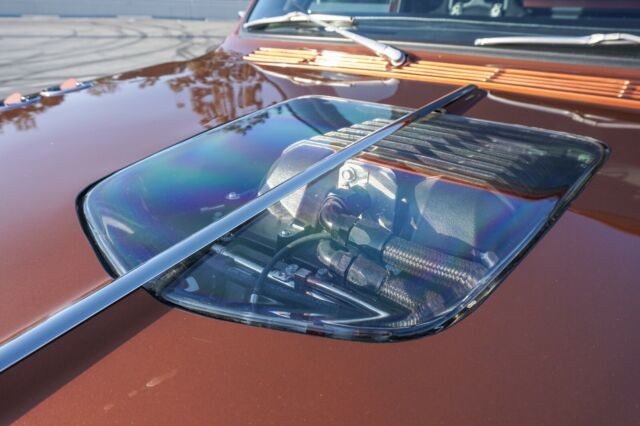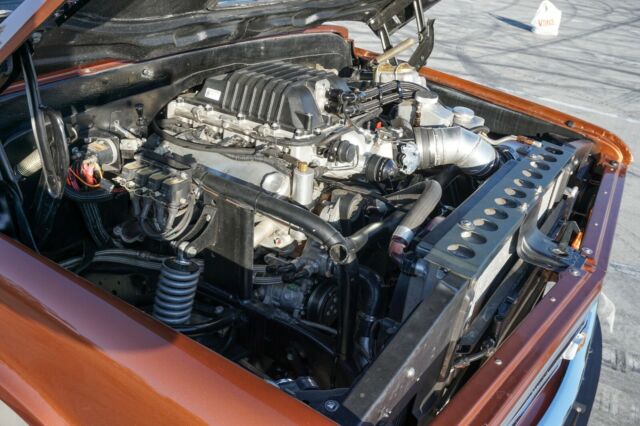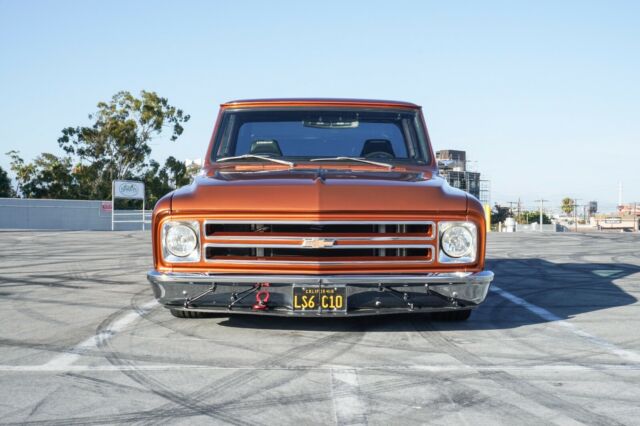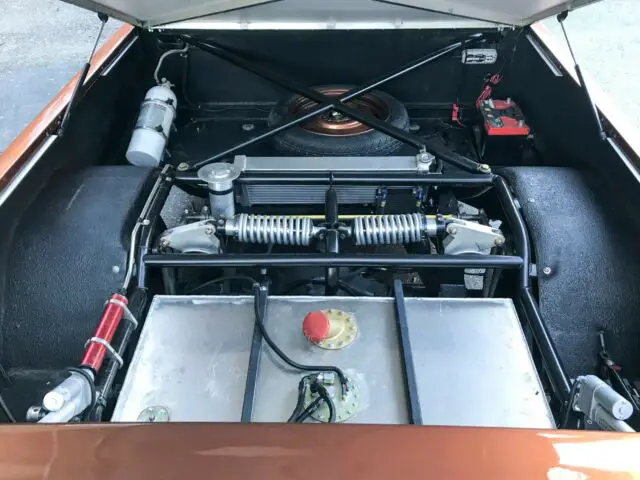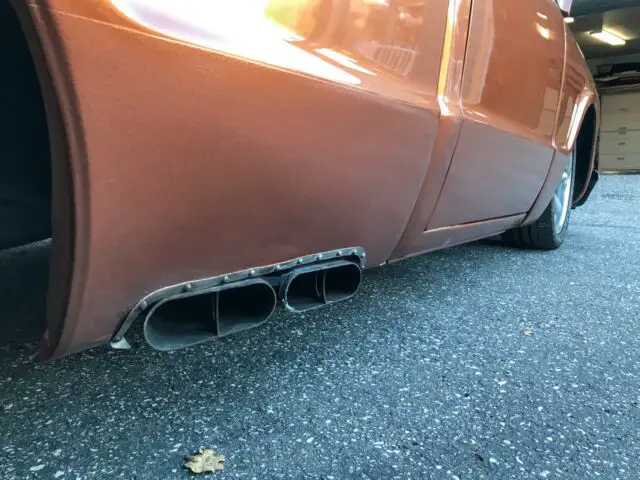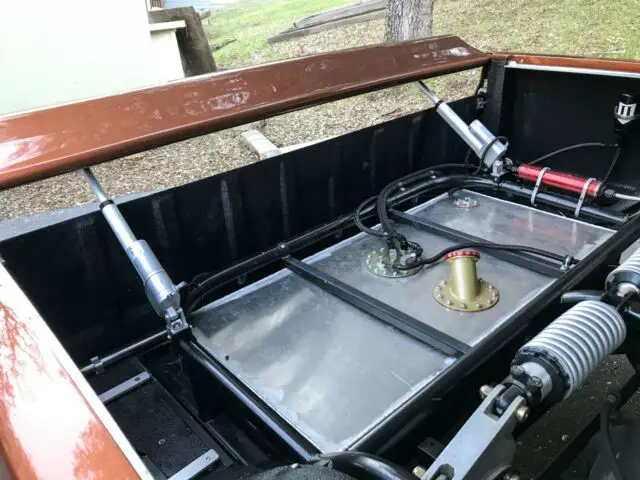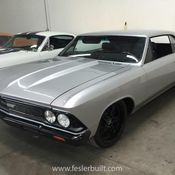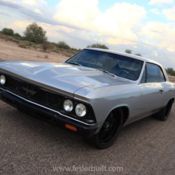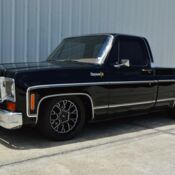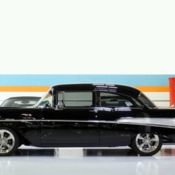Supercharged Pro-Touring pickup -- built by Hollywood Hot Rods
| Condition: | Used |
| Make: | Chevrolet |
| Model: | C-10 |
| Year: | 1967 |
| Mileage: | 800 |
| VIN: | CS141Z652315 |
| Vehicle Title: | Clean |
| Item location: | Santa Monica, California, United States |
| Extras |
| Listed by | Private seller |
Description of 1967 Chevrolet C-10 |
|
1967 Chevrolet C10 – Built by Hollywood Hot Rods This brand new, dead-serious pro touring Chevrolet C10, engineered and professionally built by Hollywood Hot Rods as a combination street/track/show truck, has suspension, braking system and running gear from NASCAR Winston Cup and Superspeedway race cars and power from a new factory supercharged LS engine. Every part of this truck—with the exception of the sheet metal, the chassis rails, and a rebuilt transmission and third member—is brand new: 6.0 LS engine, GM supercharger, intercooler, front and rear suspension, brakes, interior, seats, gauges, air conditioning and heat, trim, wheels and tires, rubber, glass, hoses, lines, lighting, wiring, every fastener, etc., etc. The 1967 cab, fenders, grille, core support and Fleetside short bed are all channeled 3 ½” over the 1971 frame. Nothing shows beneath the rocker panels, and nothing hangs below the scrub line. The cab and full roll cage are welded solidly to the frame using high-quality TIG welds, creating a strong monocoque structure. The frame is strengthened with round and square tube bracing and crossmembers, then TIG-welded to a 12-point DOM 1 ¾” steel tubing roll cage that spans the full length of the frame. The cage includes X-members in the cab and the bed and heavily-braced downtubes in the engine compartment, making for an exceptionally rigid, fully-triangulated base platform comparable in stiffness to a Superspeedway frame. No junk wire welds, no shortcuts and no excuses. The front suspension uses unequal-length tubular A-arms and long-travel, double-adjustable QA1 14” coilovers, with a wide range of height, rebound and compression tunability, from full soft for the street to full hard for the track. The forged tall spindles with heavy-duty Cup car tapered bearings and aluminum Stock Car Products hubs were custom-built by a North Carolina NASCAR race shop. Steering comes from a strong, proven NASCAR-spec ACR lightweight variable ratio competition steering box rather than a rack-and-pinion setup, to maximize steering feel and minimize potential breakage. All front end pivot points, bushings and ball joints are brand new low-friction MOOG heavy duty NASCAR race units. Unlike many pro touring builds, this one steers easily, has plentiful suspension travel, soaks up irregular road surfaces and goes straight down the road with no drama, darting, wandering or tramlining. Nothing rubs, scrapes, or bottoms out. The rear suspension features four-foot Chevy truck arms, a heavy-duty adjustable custom tubular panhard bar and a Formula 1-style cantilevered, pushrod-actuated QA1 12” coilover system, double adjustable from above and center-mounted to minimize sideloads and chassis flex. The long travel of all four QA1 coilovers insures a relatively soft, compliant ride on the street—but is easily and quickly adjustable to full stiffness at the track. All pivot points of the rear suspension swing on permanently-lubricated sintered bronze bushings. Both front and rear suspensions include interchangeable and tunable NASCAR splined arm swaybars mounted in pillow blocks. Ride height is multi-adjustable on all four corners to maximize corner-weighting potential and balance. The rear axle is a NASCAR full-floater Ford 9” with 31-spline competition axles and 3.90 gearing from Stewart-Haas Racing. It includes a full-circulation, belt-driven, single-stage Johnson oiling pump, differential cooler and remote reservoir. The 4” aluminum driveshaft, also from Stewart-Haas, uses Dana Spicer 1330 U-joints. The 20-piston braking system features massive 6-piston front and 4-piston rear Wilwood Superspeedway calipers on 13” grooved rotors, all 1.25” thick, with separate bolted and safety-wired aluminum hats and street/track compound pads. The 1” bore dual chamber Corvette master cylinder is boosted by an 1800 PSI Hydrastop hydraulic power assist unit, driven by a NASCAR Sweet power steering pump with a remote reservoir, a remote cooler and Dirty Dingo heavy duty billet mounting brackets. All brake lines are stainless; all flex lines are braided steel; the system holds Spec 5 racing brake fluid distributed to the calipers through a cab-mounted adjustable NASCAR crank-type bias control proportioning valve. This same braking system stops Superspeedway racecars repeatedly from 200 mph with no fade or overheating. Unless you’ve driven a NASCAR race car, you’ve never experienced this kind of braking force. The truck is powered by a new Chevrolet LQ4 HP93 iron block LS-series 6.0 liter crate engine from ATK, with aluminum 341-series 71 cc heads, 9.5 to 1 compression, custom roller cam, 90 lb/hr injectors, boosted by a new (not remanufactured) GM ZL1 supercharger with bed-mounted intercooler and GM heat exchanger pump from Boost District. The engine, set back a foot from its factory location in a recessed and smoothed firewall, has a Holley EFI 105mm low RPM taper throttle body, a sealed cold air intake and filter system integrated into the core support, a billet oil vapor recovery system, and a high-cfm Edelbrock water pump. Exhaust flows through mid-length, heat-coated Street & Performance four-bolt flange headers that dump into twin Magnaflow bullet catalytic converters, dual Spintech mufflers and a NASCAR boom tube that exits on the passenger side of the bed. The truck sounds throaty, powerful and mean without being offensively loud. The transmission is a 4L65E with a 2400-rpm stall RevMax torque converter; shifted by a TCI CAN system with steering wheel-mounted paddle shifters and a gated console-mounted Winters Art Carr shifter; all driven by a tunable TCI transmission controller with built-in touch-screen diagnostics in the center console. A 4 ½” thick double-pass aluminum C&R short-track NASCAR radiator cools the supercharged LS motor, which runs consistently at 195 degrees as designed, with its custom-built Derale twin fan/shroud system and custom aluminum recovery and vapor tanks. The transmission has a thermostatically-controlled remote Derale trans cooler with a dedicated fan and integral front-facing core support air intake. The remote frame-mounted engine oil cooler also comes from Derale. Every lubricant and coolant system, including the power steering and Hydrastop power braking booster, has its own dedicated cooler. All fluids are synthetic. Nothing leaks or drips. Every hose on the truck is lightweight braided Kevlar or braided steel (and man, was that expensive, or what). The fuel system starts with a custom-built, internally-baffled 32 gallon NASCAR-style quick-fill aluminum fuel cell mounted in its own protective cage at the rear of the bed. From there forward, all fuel components are Aeromotive, including the 340 gph in-tank pump, stainless steel filters and regulator. The system also features a dash-mounted Aeromotive digital pulse modulated fuel pump controller that minimizes fuel pump loads at cruising speeds and maximizes flow at high boost; and a bed-mounted custom II Much charcoal canister that stops fumes from escaping the fuel system and stinking up your garage. With the 36-gallon fuel cell filled to 25 gallons, the truck’s weight balance is exactly 50/50 front to rear. The bed of the truck has a custom-built, aluminum-framed, strut-suspended marine vinyl-covered hard tonneau cover with quick-release hinges. Inside the bed a space saver spare tire, jack and one-inch drive lug wrench provide an extra measure of road readiness. The electrical system, based around a Ron Francis XP-66 Express series 20-circuit wiring harness, is powered by a 140-amp GM alternator and a new bed-mounted Optima Red Top battery, and features a dash-actuated Flaming River remote master disconnect switch, dash-mounted fusebox and an ACS competition solid-state NASCAR switch panel that controls all electrical functions through heavy-duty relays. Seats are Corbeau LG1 lightweight leather and suede racing buckets with four-point Corbeau harnesses on inertia reels and adjustable, inflatable lumbar support in the driver’s seat. The dash holds a full complement of nine Stewart-Warner competition gauges. Air conditioning and heat are from Vintage Air (and will freeze you out of the cab). A 13” Momo Champion competition leather and Alcantara wheel turns a 32” Ididit 8-position tilt column. The custom built aluminum dash and center console also feature billet A/C vents; switches for the power windows (with GM motors); indicator lights for turn signals and high beams; a console storage bin and a new custom dash pad. Fire suppression is provided by a SafeCraft bed-mounted extinguisher bottle and heat-activated automatic release system mounted high on the roll cage in the cab, as well as a cab-mounted quick release H&R Performance Halon chrome extinguisher. The 1967-1972 Chevrolet C10 half-ton Fleetside pickups were famously designed by Harry Bentley Bradley, who I met and who inspired the building of this truck. Aside from trim removal, the Moal Coachbuilders-designed hidden articulated spoiler integral to the tailgate, and a VPN fiberglass hood with operable custom-made venturi-style louvers and a Lexan supercharger window from the ZR1 Corvette, all body panels are stock. All lower body panels—from the front fenders through the doors, rockers and bedsides, are coated in thick, transparent SunTek protective film. At the rear, concealed behind the bumper and the receiver-mounted license plate, is a Class 3 hitch with four-pin electrical outlet. Show-level chrome plating on all newly-plated parts comes from Sherm’s Custom Plating in Sacramento. The truck generates aerodynamic downforce via a full-width Tegrin front splitter from a NASCAR COT racer, secured with Joe’s Racing aluminum spoiler supports; and in the rear from a unique, custom made Moal-designed integral articulated tailgate spoiler electrically controlled by dual adjustable electro-hydraulic rams and a console-mounted wing switch in the cab. The attack angle of the rear spoiler is fully adjustable, and completely disappears into the top portion of the tailgate when it isn't deployed. Wheels are 5-on-5 Esajian Wheel custom-made reverse-contour five-spoke 18x8 and 18x11, built specifically for this truck to fit NASCAR 3” aluminum race hubs and 5/8”-18 wheel studs, and shod with new Michelin Pilot Super Sport tires. The lug nuts are custom-made by Desolate Motor Sports. Paint and body work from Van’s Classic Car Auto Body in Grass Valley, California features two-stage metallic Spies-Hecker paint in a 2004 Infiniti R12 code factory-pack color called Liquid Copper. Before the new paint was applied, the entire truck was stripped to bare metal by hand—not dipped or chemically stripped. Only the passenger side rocker panel was found to have any rust, and the entire panel was cut out and replaced with a new one. Both rear cab corners have vertical relief slots to prevent any future moisture retention or corrosion. The active title (without any non-op or salvage status) is clear, clean and in my hands, registered as a 1973 in California because it was first sold then, along with 11 years of registration information and voluminous receipts from the entire build and the many component suppliers. California registration tags are current until June of 2020, with no excuses, back fees or other DMV issues, and because of its year of registration, the truck will always be fully California smog-exempt. This brand new, well-sorted, unique truck is ready to drive across the country or to your local track, show, autocross event or photo shoot for a magazine feature—several major magazines have already expressed interest. I planned to keep this truck permanently (before a prostate cancer diagnosis), so no expense was spared in the 8-year build, which utilized the best builders in California and the finest, highest-quality parts available. When making parts choices, price was not considered—only quality. Every component is the best, and usually the most expensive one in its category. I estimate the total cost of the build at $130,000. For the sake of complete transparency, these are the only minor issues I know of: the indicator screen on the TCI paddle shifter assembly intermittently stops lighting, and TCI says it needs a stronger spring or longer shim in the turn signal contact mechanism – a simple fix. The floor covering in the cab has a two-foot seam that needs cosmetic finishing. The passenger side inside steel door panel has two minor dents, easily dealt with by a paintless dent guy. The tonneau cover has no locking mechanism, but one could be added without much work. (The photos, by the way, were taken at a West LA skidpad -- no tires were harmed in the making of this listing.) If you know what you're looking at, you'll recognize the rarity of this truck. Hollywood Hot Rods creates only high-end builds, and they rarely change hands or sell on EBay, so this is a unique opportunity to own something remarkable. Questions? Call me, David Langness, at 310-702-1919, and I’ll be happy to answer them. The truck can be seen in Santa Monica, California by appointment. Thanks to Troy Ladd and the crew at Hollywood Hot Rods in Burbank, Jack Chisenhall at Vintage Air in San Antonio, the Moal family in Oakland, Joe Silva at Concept Motorsports, Harry Bentley Bradley and everyone else who helped bring this unique truck together. |
 Home
Home Contact us
Contact us NEWEST CARS
NEWEST CARS SELL YOUR CAR
SELL YOUR CAR FAQ
FAQ